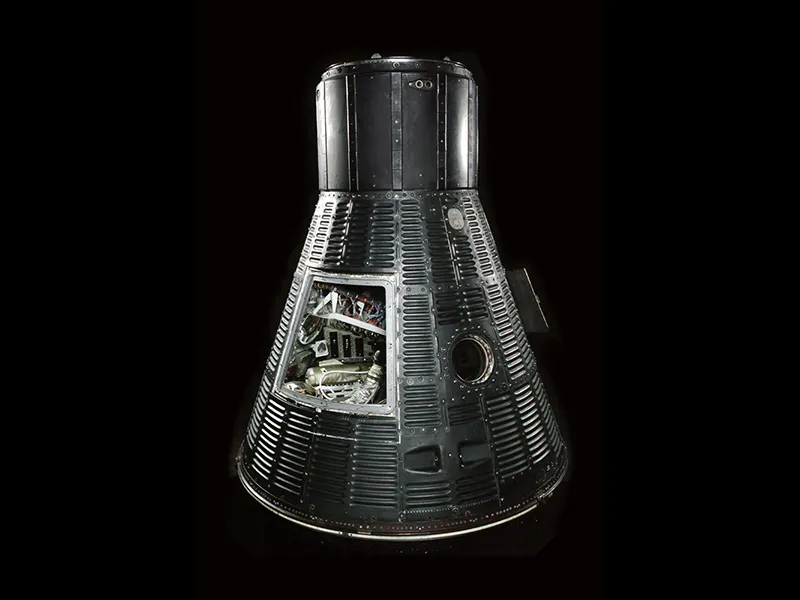He Was the Fifth Man on the Moon, But That Wasn’t His Most Famous Flight
Two trips, a decade apart, spanned the most exciting era in space history.
:focal(593x215:594x216)/https://tf-cmsv2-smithsonianmag-media.s3.amazonaws.com/filer/3d/9d/3d9dda03-76ae-4b59-9b50-ded019a839b8/12b_fm2021_armstrongswindowshepard_as14-66-9230_live.jpg)
Of the original seven astronauts chosen by NASA in 1959, only one, Alan Shepard, made it to the moon. And he almost didn’t. More than two years after his pioneering Mercury-Redstone flight in May 1961, Shepard was in training to command the first two-man Gemini mission. Progress to the moon was planned in three steps: Mercury to prove that space travel was feasible, Gemini to demonstrate rendezvous and long-term spaceflight, and Apollo to go all the way. In 1963, Shepard was a fair bet to fly all three.
Then an obscure inner ear condition knocked him off flight status for almost six years, during which time he was given a desk job running NASA’s astronaut office. For a man of Shepard’s ego and drive, it was purgatory. Years later, he confessed to interviewer David Frost: “I was probably harder on the astronauts than I should have been…. It was frustrating to go down to the Cape, pat these guys on the back and watch them fly like I wanted to. It was a very difficult period for me.”
All the lunar astronauts-in-training were competitive, although their interests varied. While some viewed Apollo as exploration, others saw it as the world’s greatest flight test program. Shepard, like Neil Armstrong, was more in the latter camp. His 15-minute suborbital Mercury flight had been all engineering business. No enthusiastic cry of “Let’s go! ” at launch, like Gagarin—just a simple “Liftoff, and the clock is started.” NASA and Shepard prided themselves that the American astronaut demonstrated manual control of his tiny spacecraft, unlike the Russian cosmonaut, who was just along for the ride.
The first American spaceflight had presented many dangers, from the launch to the recovery at sea. (Navy balloonist Victor Prather had drowned in the Gulf of Mexico just a day earlier when his nearly identical pressure suit filled with water.) Shepard himself was an important part of the experiment. In the Bahamas shortly after splashdown, then again in Florida, NASA doctors inspected him like technicians going over a machine part. They got him to cough, burp, say ahhhh, and stand on one foot. They scrutinized a mark on his skin (where a buckle had dug in), and paused to discuss a chigger bite. He was perfectly healthy. Spaceflight was in fact safe.
After an experimental surgery fixed his ear problem in 1968, Shepard was raring to go to the moon. He used his influence to butt in line ahead of other astronauts awaiting flight assignments, and grabbed one for himself. When Apollo 14 launched, he had spent just five minutes in space, and crewmates Ed Mitchell and Stu Roosa had never flown. At 47, he was also the oldest Apollo commander by several years. When he stepped onto the highlands of Fra Mauro on February 5, 1971, the fifth person to walk on the moon, capcom Bruce McCandless ribbed him, “Not bad for an old man.”
Before that decade was out, a new stereotype of the astronaut would replace the old boy scout image from Mercury days, and Shepard was its perfect embodiment—the Corvette-racing guy who hit a golf ball on the moon. But toward the end of his life, he told David Frost that going to the moon had given him “a new maturity,” and he became more willing to discuss the emotional side of that historic trip. Looking up at Earth from the moon’s surface, he admitted to TV interviewer Charlie Rose: “I actually wept a little bit. I hadn’t expected to do that.”
The Destination Moon gallery will honor the steely astronaut who made the first U.S. flight into space by exhibiting his Mercury suit and capsule. By the end of his career, the astronaut turned out to be more than just a machine after all.
Destination Moon is made possible by the generous support of:
Apollo 11 Commemorative Coin Program | Jeff and Mackenzie Bezos | Joe Clark | Charles and Lisa Simonyi Fund for Arts and Sciences | Bruce R. McCaw Family Foundation | Elizabeth H. and James S. McDonnell III Fund (at the St. Louis Community Foundation) and The JSM Charitable Trust | John and Susann Norton | Phillip N. and Mary A. Lyons | Gregory D. and Jennifer Walston Johnson | Barry D. Friedman | Leora and Derek Kaufman | FedEx Corporation | The Beall Family | Milann H. Siegfried | OMEGA | Robert Procop

/https://tf-cmsv2-smithsonianmag-media.s3.amazonaws.com/filer/8d/e3/8de3b222-3f91-4bc4-8fc5-795a4a0a49b8/spacesuit.jpg)
